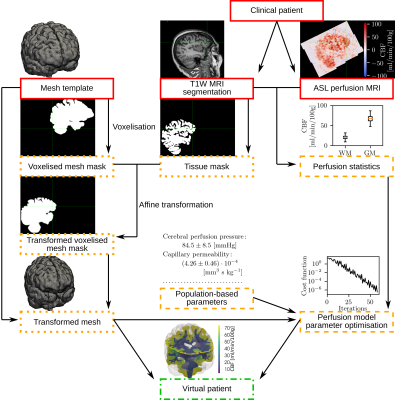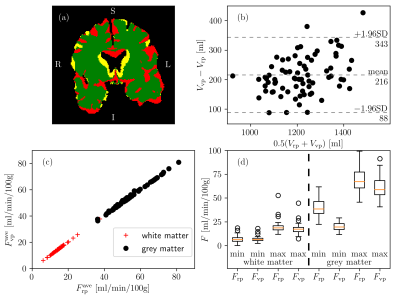Tamás I. Józsa1, Jan Petr2, Alle Meije Wink3, Frederik Barkhof3, Henk J. M. M. Mutsaerts3, and Stephen J. Payne1
1Department of Engineering Science, University of Oxford, Oxford, United Kingdom, 2Institute of Radiopharmaceutical Cancer Research, Helmholtz-Zentrum Dresden-Rossendorf, Dresden, Germany, 3Department of Radiology and Nuclear Medicine, Amsterdam University Medical Center, Amsterdam, Netherlands
1Department of Engineering Science, University of Oxford, Oxford, United Kingdom, 2Institute of Radiopharmaceutical Cancer Research, Helmholtz-Zentrum Dresden-Rossendorf, Dresden, Germany, 3Department of Radiology and Nuclear Medicine, Amsterdam University Medical Center, Amsterdam, Netherlands
Virtual brains were generated for a mechanistic perfusion simulator. Semi-patient-specific brain meshes were obtained based on T1-weighted MRI scans. Model parameters, such as tissue permeabilities, were optimised to match perfusion statistics obtained from ASL perfusion MRI.

Figure 1. Schematic drawing of the virtual patient generation pipeline. Solid boxes: input; dash-dotted box: output; dotted boxes: quasi-patient-specific mesh generation; dashed boxes: model parameter tuning.

Figure 2. (a) Coronal view of the affine registration from the mesh to the patient space, with overlap (green), patient only (yellow) and mesh only (red). (b) Bland-Altman plot of the brain volume corresponding to virtual ($$$V_{vp}$$$) and real patients ($$$V_{rp}$$$). (c) Average (ave) CBF values in virtual ($$$F_{vp}$$$) and real ($$$F_{rp}$$$) patients. (d) Minimum (min) and maximum (max) CBF values in real and virtual patients.
